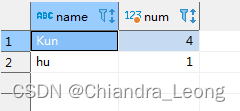mysql 联合索引去查询的逻辑
根据名字去分组统计有多少个同名
select name,count(*) as num from demo.`user` group by name

剖析下这个sql语句的底层执行流程:
explain select name,count(*) as num from demo.`user` group by name

Using temporary:表示在执行分组的时候使用了临时表
Using filesort:表示使用了排序
参考:https://www.php.cn/mysql-tutorials-487665.html
group by + where 的执行流程
加入条件 年龄大于等于20的才进行统计
select name,count(*) as num from demo.`user` where age <= 20 group by name
再去剖析一下
explain select name,count(*) as num from demo.`user` where age <= 20 group by name

扫描了五条
我们给它加个条件,并且加个idx_age的索引,如下:
alter table demo.`user` add index idx_age(age)
再去剖析:

从explain 执行计划结果,可以发现查询条件命中了idx_age的索引,并且使用了临时表和排序
执行流程如下:
1、创建内存临时表,表里有两个字段city和num;
2、扫描索引树idx_age,找到大于年龄大于30的主键ID
3、通过主键ID,回表找到city = ‘X’
判断临时表中是否有为 city='X’的行,没有就插入一个记录 (X,1);
如果临时表中有city='X’的行的行,就将x 这一行的num值加 1;
4、继续重复2,3步骤,找到所有满足条件的数据,
5、最后根据字段做排序,得到结果集返回给客户端。
如果想去除索引:
alter table demo.`user` drop index idx_age
group by + having的执行流程
select name,count(*) as num from demo.`user` group by name having num > 2
group by + where + having的执行顺序
select name,count(*) as num from demo.`user` where age <= 20 group by name having num > 1
·执行where子句查找符合年龄大于19的员工数据
·group by子句对员工数据,根据城市分组。
·对group by子句形成的城市组,运行聚集函数计算每一组的员工数量值;
·最后用having子句选出员工数量大于等于3的城市组。
